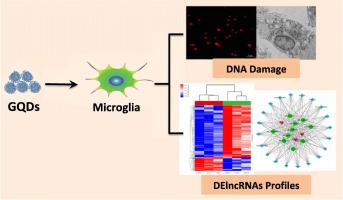当前位置:
X-MOL 学术
›
NanoImpact
›
论文详情
Our official English website, www.x-mol.net, welcomes your
feedback! (Note: you will need to create a separate account there.)
Differentially expressed profiles of long non-coding RNA in responses to graphene quantum dots in microglia through analysis of microarray data
NanoImpact ( IF 4.7 ) Pub Date : 2020-07-01 , DOI: 10.1016/j.impact.2020.100244 Tianshu Wu , Xue Liang , Yimeng Li , Xi Liu , Meng Tang
NanoImpact ( IF 4.7 ) Pub Date : 2020-07-01 , DOI: 10.1016/j.impact.2020.100244 Tianshu Wu , Xue Liang , Yimeng Li , Xi Liu , Meng Tang

|
Abstract Graphene quantum dots (GQDs) have a bright prospect to be applied in the field of biomedicine and have been reported to be associated with adverse events in the central nervous system, but it is still not clear of their underlying mechanisms. After observing the adverse effects, including decreased cell viability, DNA damage, and impairments of intracellular structure, caused by nitrogen-doped GQDs (N-GQDs) and amino-functionalized GQDs (A-GQDs), a microarray analysis was conducted to comprehensively gain the information on the neurotoxic molecular mechanisms of N-GQDs and A-GQDs, which is associated with long non-coding RNAs (lncRNAs) proposed to participate into multiple neuronal disorders. The exclusive differentially expressed lncRNA (DElncRNA) transcripts by N-GQDs at different exposure doses or A-GQDs were collected to do the functional analysis in order to find the pathways of GQDs causing toxic effects in microglia under different circumstances. Meanwhile, the findings suggested the pathways in which the shared DElncRNAs involved could play indispensable roles in neurotoxicity of N-GQDs and GQDs no matter with what surface modification, such as wnt, calcium and MAPK signalling pathways. Moreover, protein-coding genes cis- and/or trans-regulated by these DElncRNAs or transcriptional factors (TFs) interacted with DElncRNAs were detected, like sox4, hoxc9 and pou3f1, in this study. Therefore, lncRNAs identified by the omic approach could be useful candidate biomarkers or protective targets in neurotoxicity of GQDs, which indicated the pivotal role of post-transcriptional regulation in toxicity of graphene-based nanomaterials.
中文翻译:

通过分析微阵列数据,响应小胶质细胞石墨烯量子点的长非编码 RNA 的差异表达谱
摘要 石墨烯量子点(GQDs)在生物医学领域有着广阔的应用前景,已被报道与中枢神经系统的不良事件相关,但其潜在机制尚不清楚。在观察氮掺杂 GQDs (N-GQDs) 和氨基功能化 GQDs (A-GQDs) 引起的细胞活力降低、DNA 损伤和细胞内结构受损等不良反应后,进行微阵列分析以综合获得N-GQDs 和 A-GQDs 的神经毒性分子机制的信息,这与被提议参与多种神经元疾病的长链非编码 RNA (lncRNAs) 相关。收集N-GQDs在不同暴露剂量或A-GQDs下唯一差异表达的lncRNA(DElncRNA)转录本进行功能分析,以寻找不同情况下GQDs在小胶质细胞中引起毒性作用的途径。同时,研究结果表明,无论进行何种表面修饰,如 wnt、钙和 MAPK 信号通路,共享的 DElncRNA 参与的通路都可以在 N-GQD 和 GQD 的神经毒性中发挥不可或缺的作用。此外,在本研究中检测到由这些 DElncRNA 或与 DElncRNA 相互作用的转录因子 (TF) 顺式和/或反式调节的蛋白质编码基因,如 sox4、hoxc9 和 pou3f1。因此,通过组学方法鉴定的 lncRNA 可能是 GQD 神经毒性的有用候选生物标志物或保护靶标,
更新日期:2020-07-01
中文翻译:

通过分析微阵列数据,响应小胶质细胞石墨烯量子点的长非编码 RNA 的差异表达谱
摘要 石墨烯量子点(GQDs)在生物医学领域有着广阔的应用前景,已被报道与中枢神经系统的不良事件相关,但其潜在机制尚不清楚。在观察氮掺杂 GQDs (N-GQDs) 和氨基功能化 GQDs (A-GQDs) 引起的细胞活力降低、DNA 损伤和细胞内结构受损等不良反应后,进行微阵列分析以综合获得N-GQDs 和 A-GQDs 的神经毒性分子机制的信息,这与被提议参与多种神经元疾病的长链非编码 RNA (lncRNAs) 相关。收集N-GQDs在不同暴露剂量或A-GQDs下唯一差异表达的lncRNA(DElncRNA)转录本进行功能分析,以寻找不同情况下GQDs在小胶质细胞中引起毒性作用的途径。同时,研究结果表明,无论进行何种表面修饰,如 wnt、钙和 MAPK 信号通路,共享的 DElncRNA 参与的通路都可以在 N-GQD 和 GQD 的神经毒性中发挥不可或缺的作用。此外,在本研究中检测到由这些 DElncRNA 或与 DElncRNA 相互作用的转录因子 (TF) 顺式和/或反式调节的蛋白质编码基因,如 sox4、hoxc9 和 pou3f1。因此,通过组学方法鉴定的 lncRNA 可能是 GQD 神经毒性的有用候选生物标志物或保护靶标,











































 京公网安备 11010802027423号
京公网安备 11010802027423号